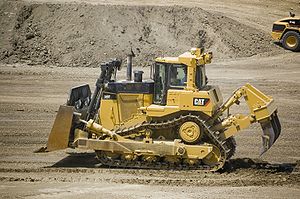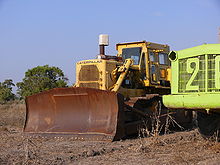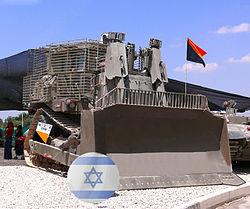- Caterpillar D9
-
Caterpillar D9 - General Characteristics 
Engineering Role: Heavy bulldozer Propulsion: Caterpillar tracks Engine model: CAT C18 ACERT (D9T)
3408 HEUI (D9R)Gross power: 464 hp (346 kW) D9T
474 hp (354 kW) D9RFlywheel power: 410 hp (306 kW) D9T
410 hp (306 kW) D9R
375 hp (280 kW) D9N
460 hp (343 kW) D9LDrawbar pull: 71.6 tons Operation Weight: 108,000 lbs (48,784 kg) Length: 26.5 ft (8.1 m) Width: 14.7 ft (4.5 m) (blade) Height: 13 ft (4 m) Speed: 7.3 MPH (11.9 km/h) Forward
9.1 MPH (14.7 km/h) ReverseBlade capacity: 17.7 yd³ (13.5 m³) 9 SU blade
21.4 yd³ (16.4 m³) 9 U bladeThe Caterpillar D9 is a large track-type tractor designed and manufactured by Caterpillar Inc. Though it comes in many configurations it is usually sold as a bulldozer equipped with a detachable large blade and a rear ripper attachment.
The D9, with 354 kW (474 hp) of gross power and an operating weight of 49 tons, is in the upper end (but not the heaviest), of Caterpillar's track-type tractors, which range in size from the D3 57 kW (77 hp), 8 tons, to the D11 698 kW (935 hp), 104 tons.
The size, durability, reliability, and low operating costs have made the D9 one of the most popular large track-type tractors in the world. The Komatsu D275A is one of its most direct competitors.
Contents
Engineering and technical description
The D9 is a series of heavy tracked-type tractors, propelled by Caterpillar tracks and usually used as bulldozers. It came out as a protoype in 1954 as a D9X. Ten D9X prototype models were built in 1954. In 1955, the 286 hp (213 kW) D9 was introduced to compete against the Euclid TC-12 which had more power. The D9 would come equipped with a 1,473 cid D353 which would power the D9 right up until the 1980 introduction of the D9L. In 1956 the D9 got a boost up to 320 hp (240 kW). The new 335 hp (250 kW) D9E would replace that model in 1959. Two years later, the legendary 385 hp (287 kW) D9G would appear in 1961 and would be on the scene for the next 13 years. Over its 13-year life the D9G would be the main crawler on many job sites testifying to its sturdiness and design.
In 1965, west coast businessman Buster Peterson hooked up a pair of D9Gs to pushload the largest wheel tractor scrapers built. In 1986 Caterpillar bought the rights to this concept and thus the 770 hp (570 kW) DD9G was created (D stands for Dual D9G). Peterson also built the first SxS D9G which has two D9Gs side-by-side, pushing a 24-foot (7.3 m) wide bulldozer blade.
In 1969, Caterpillar introduced this new SxS D9G. In 1974, the improved 410 hp (310 kW) D9H was introduced to replace the D9G. The D9H is still the more powerful conventional track-type tractor in company history. The DD9H and the SxsD9H would soon follow.
The D9 is the real star of the 1974 ABC cult classic movie "Killdozer".
In 1980, the 460 hp (340 kW) D9L was introduced. The unit had the same elevated drive sprocket undercarraige that the larger D10 had. Between 1970-71 a D9G was built with an elevated drive sprocket undercarriage. A picture of one can be found on page 95 in a book called "Caterpillar Chronicle" by Eric Orlemann. The D9 has undergone several generations of engineering enhancements. Each new model is denoted with an English letter added to D9 like D9E, D9G, D9H, D9L, D9N, D9R, and the current D9T.
The D9L was the first variation of the D9 to employ elevated drive sprocket design in which the drive sprocket is elevated above the track, and not on the ground. The elevated drive sprocket gives the "belly pan" more ground clearance. The elevated drive sprocket undercarriage is a modular design. To repair the machines one breaks down the tracks and pulls the drive sprockets out. As a result, one can pull the powershift transmission out the rear. The 370 hp (280 kW) D9N replaced the D8L in 1987.
In 1988, Caterpillar produced their 25,000th elevated drive sprocket track-type tractor which a D9N. The 405 hp (302 kW) D9R replaced the D9N in 1996. The 410 hp (310 kW) D9T replaced the D9R in 2004. The D9T has a ACERT diesel engine. The current versions are the D9R and the D9T models, but older models such as the D9N and D9L are still common. The L, N, R and T models of the D9 are visually very similar, differing primarily in the design of their internal systems.
The D9L was replaced by the 520 hp (390 kW) D10N in 1987. The 370 hp (280 kW) D9N replaced D8L in 1987. The The D9T main difference from the D9R is the installment of the new Cat C18 ACERT engine. The D9L is the most powerful D9 in history, with a flywheel power of 460 hp. The D9L is also heaviest D9 in history at 130,000 lbs.This model was replaced by the 520 hp D10N in 1987.
The D9's primary working tools are the blade, affixed to the front and controlled by six hydraulic arms, and the optional ripper, which can be attached to the back. The blade is mainly intended for earthmoving and bulk material handling: pushing up sand, dirt, and rubble. It also can be used to push other heavy equipment such as earthmoving scraper pans, and in military applications, main battle tanks. The dozer blade usually comes in three variants:
- A Straight Blade ("S-Blade") which is short and has no lateral curve, no side wings, and can be used for fine grading.
- A Universal Blade ("U-Blade") which is tall and very curved, and has large side wings to carry more material.
- A "S-U" combination blade which is shorter, has less curvature, and smaller side wings. This blade is typically used for pushing piles of large rocks, such as at a quarry.
Like many other bulldozers, the D9 can be fitted with different blades (such as size-9 SU blade and Universal blade) or other devices such as mineplows.
The rear ripper is intended for use in loosening rocky ground and ripping out larger stones. It can also break frozen ground and excavate small ditches. The ripper can be replaced with a multi-shank ripper, allowing the bulldozer to comb the ground.
The size, power and weight of the larger track-type tractors dictate that they are used primarily for major projects. The D9 is most commonly found in use in construction, forestry, mining, waste, and quarry operations.
Military applications
 An armored IDF Caterpillar D9R bulldozer, nicknamed "דובי" (Teddy bear) in Israel.
An armored IDF Caterpillar D9R bulldozer, nicknamed "דובי" (Teddy bear) in Israel.
Its armor allows it to work under heavy fire.See also: Armored bulldozer, IDF Caterpillar D9, and House demolition in the Israeli-Palestinian conflictCaterpillar Inc. does not manufacture a military version of the D9 per se, but the attributes that make the D9 popular for major construction projects make it desirable for military applications as well, and in this role - with Israeli modifications and armor - it has been particularly effective for the Israel Defense Forces (IDF) and later for the United States armed forces (the Marine Corps and the US Army) in Iraq.[1]
The Israeli Engineering Corps used armored versions of the D9L, D9N and D9R to clear booby-trapped areas, open routes, rescue stuck armored fighting vehicles and build sand mounds.[citation needed] During the Al Aqsa Intifada D9 bulldozers were used to demolish houses under fire, as the dozers withstood massive IEDs (some of 200 kg and even 500 kg of explosives) and even deflected RPG rounds and were impervious to machinegun fire.[2] The armored D9 bulldozers were cited by experts as one of the key factors for the relatively low casualties of the IDF in urban warfare.[3] However, while Israel saw the utilization of bulldozers as a security necessity, it drew controversy for the destruction it caused to Palestinian property (mainly the destruction of Palestinian houses), especially in Rafah and in Jenin (during Operation Defensive Shield).
On February 7, 2006, the Synod of the Church of England decided to divest itself of approximately USD$2.2 million in Caterpillar Inc. shares, property of the Church of England. This was seen as a move to distance itself from the Israeli army's documented[4] use of the Caterpillar bulldozers to destroy Palestinian homes.
The family of Rachel Corrie, an American who was killed with a Caterpillar tractor while protesting Israeli military action in Gaza, filed a lawsuit against the IDF and Caterpillar, but it was rejected by the US court. ISM eye-witnesses claim that the bulldozer deliberately ran over and crushed Corrie, while IDF military police investigation found that the driver did not see Corrie and concluded her death was an accident. [5]
The US army used D9 bulldozers to clear forest in the Vietnam war but after the war they were replaced with smaller and cheaper Caterpillar D7G bulldozers. D7G dozers are still very common in US combat engineering battalions, but there is a resurgent high demand to replace the lighter D7Gs with the newer and more heavily armored D9s.
See also
- Heavy equipment
- Israeli Engineering Corps
- Killdozer—a 1974 ABC movie
References
- ^ Video of US Army / US Marine teams working with civilian contractors from KBR Heavy Equipment Transport, using D9s at Ar Rutbah to build a large defensive berm
- ^ The blade that won the battle, Israeli Intelligence Heritage Center (Hebrew)
- ^ Urban Warfare and the Lessons of Jenin, Yigal Henkin
- ^ Video: Gaza: The Killing Zone, 2003
- ^ [1] Rachel Corrie Facts
External links
- Caterpillar D-Series Track-Type Tractors - Official Caterpillar website
- Book "Caterpillar D9 - D9R" by Thomas Wilk & Urs Peyer
- Hebrew Article about the D9 bulldozer and its military applications, the Hebrew Wikipedia
- MathKnight's IDF Caterpillar D9 armored bulldozer webpage - mainly on military applications by the IDF
- Review on the D9G
- Army's new D9 bulldozer digs into duty in Kuwait - The US army tests the armoured D9R for the Iraqi campaign
- Engineering News: Combat Engineering in Iraq - including reviews on the D9 Dozer performance in Iraq and nice pictures of it and other CEVs
- IDF D9 bulldozer - Israeli-Weapons website
- polovni traktori polovni traktori
- Family of peace activist killed by bulldozer files lawsuit against company
Categories:- Military engineering vehicles
- Caterpillar vehicles
- United States Marine Corps equipment
- Armoured fighting vehicles of Israel
- Tracked vehicles
- Tractors
Wikimedia Foundation. 2010.



